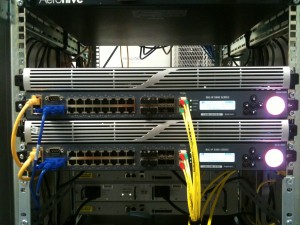My company decided to buy two F5 Big IP Local Traffic Manager 8950 for our web cluster systems with a maximum balanced capacity of 20 gigabit. We also got the F5 Local Traffic Manager as Virtual Edition for our test enviroment and to integrate it into the test network.
In the beginning the F5 looked very complicated but after some time now playing around with it and setting up things, it got easier and easier. I only need to have a deeper look at the iRules because this feature allows you can to really do everything with the F5 load balancer.
So for now I can’t really write more about it but I will soon post some updates.
Next week I have the integration of the F5 Big-IP into the production network of my company and will start setting up the first new linux web cluster but only with a layer 4 balancing.
Update:
Here a nice picture of the new F5 BigIP boxes in the data center from my company:

For the new web cluster for my company we set-up layer 4 balanced web server pools and layer 7 balanced pools.
The layer 7 balancing was necessary because there where different server pools with applications that needed to run under the same domain and where routed on the expected http/https request. I will post the iRule for everybody soon.
Here two interesting ressources to get information: